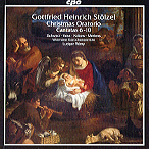Gottfried Stölzel, an almost exact contemporary of J.S. Bach, was a remarkably skilled composer, his fertile melodic imagination balanced by a keen sense of how to fit his tunes to just the right accompaniment. However, he never will be confused with Bach, who was the consummate master of such things–and who dwelt after all in an entirely different creative world known to but a few mortals. So, here we can get a rare glimpse of the very mortal Stölzel doing some of his best work in the form of five cantatas intended for performance during Christmas and Epiphany in the year 1736/37. (An earlier CPO release presented Cantatas 1-5.) All are performed by various combinations of four solo voices–mezzo, alto, tenor, and bass–and orchestra, and in typical fashion each cantata begins with a tutti “chorus” and closes with a chorale. Arias, duets, and recitatives make up the rest–there are no big orchestral sinfonias and most of the accompaniments are lean and lightly scored.
But for all the admiring descriptions in the liner notes of Stölzel’s skill at scene-painting and text illustration, it’s hard to hear these things during the performances. In fact, with two notable exceptions there’s a surprising lack of drama in these cantatas, no sense of occasion as you find brilliantly and effectively portrayed in every note and phrase in Bach’s works in the genre. Although scored with admirable economy and with a finely honed mastery of formal structure and balance of vocal and instrumental material, the music makes only an impression comparable to that of a well-dressed, proper 18th-century gentleman who speaks with educated politeness and acts with appropriate discretion–but lacks depth and substance. Arias spin out in predictable paths–pretty enough but rarely very original–and the four soloists, who generally sing well and sympathetically, seem content to keep expressive mannerisms in check.
The exceptions are the two Epiphany cantatas, where on the whole we actually find some inspired originality, more assertive text setting (Stölzel apparently wrote many of his librettos himself), and sequences of movements that build to affecting climaxes. And even in the other works we can appreciate several very lovely, first-class arias–“Verhüte, treuer Gott, in Gnaden” and “Was kann ein Auge mehr erfreuen”, both for tenor, and the delightfully Bach-like, compound-meter “Das beste Neuejahrsgeschenke”, beautifully sung by Britta Schwarz. Ludger Rémy and his Weimar Baroque Ensemble play with supreme sensitivity to the singers and to Stölzel’s characterful yet gentle style, and everyone gets fine support from CPO’s warm, detailed sound. No, this certainly isn’t Bach, but much of it is sturdy and attractive enough–especially the Epiphany works–to make for pleasing listening and an intriguing diversion for fans of Baroque sacred vocal music.
































